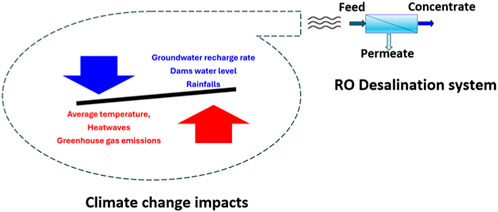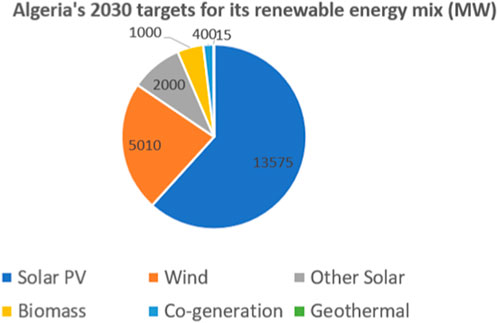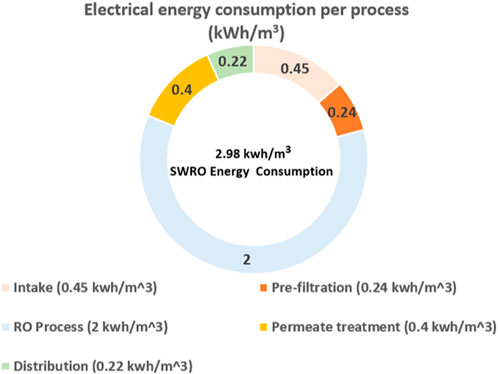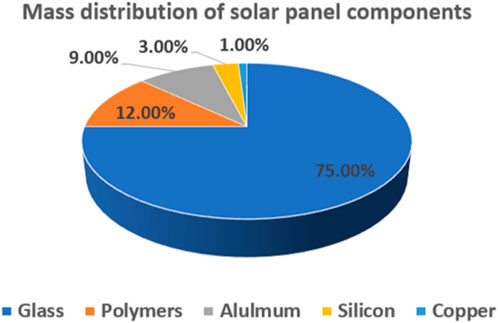Adopting sea water reverse osmosis desalination technologies for sustainable development: lessons learnt from Algiers Science and Technology for membranes 2023 workshop
- 1Department of Environmental Engineering, University of Sciences and Techniques Houari Boumediene, Bab Ezzouar, Algiers, Algeria
- 2African Membrane Society, AMSIC: Ecole Nationale d’Ingénieurs Abderhamane Baba Touré, Bamako, Mali
- 3Donyatek Company, Roanoke, VA, United States
The city of Algiers hosted the workshop on Science and Technology for Membranes from 30th May to 1st June 2023—STM 2023, held in Algeria. The main topics focused on Reverse Osmosis (RO) desalination technologies, decentralized autonomous systems, wastewater recycling for circularity, and the effects of green membrane processes on socio-economic growth. This review examines the influence of global trends and instabilities (i.e., climate change, disrupted supply chain platforms, natural disasters) on the steady supply of freshwater. The implementation of RO desalination solutions and their sustainability are assessed based on resiliency factors, which is helpful to screen water treatment alternatives based on technological benefits, ecological safety and environmental protection. Key takeaways from this study call for rolling out local membrane production capabilities, promoting the benefits of autonomous decentralized treatment systems, prioritizing innovative solutions to reduce greenhouse gas emissions, and for developing RO-specific equipment recycling infrastructures. Implementing these new tactics can lead to mitigate water scarcity and enable a sustainable deployment of desalination membrane technologies in Algeria and its region.
1 Introduction
Water scarcity crisis poses a global threat that has quickly spread under the effects of climate change. In the Middle East, Northern Africa and Southern Africa regions, hundreds of millions of people face limited access to clean water because of droughts, insufficient rainfalls and fast-depleting groundwater resources. Aside from climate instabilities, other mega trends such as global disasters (i.e., earthquakes, wildfires, pandemics, etc.) and rapid urbanization are deepening this crisis (Table 1). Against the backdrop of this alarming development, Algiers workshop enabled water treatment specialists and decision makers to discuss the emerging trends associated with seawater RO desalination (SWRO), wastewater reuse, and decentralized filtration technologies. STM 2023 agenda counted about 20 presentations devoted to SWRO matters, and a handful of others aimed at decentralized RO installations. Solicited experts, who were evenly mixed between academic and industrial professionals, contributed during lectures and at the panel sessions. Nearly two-thirds of all interventions were delivered by residing lecturers, while international attendees predominantly came from France, Africa, with very few originating from United States and the Middle East. The lectures gave a widespread assessment of new advances in membrane desalination, while panels sought to address challenges more specific to the region. This study highlights several contemporary perspectives that were shared at the meeting to assess the merits of desalination processes for solving a persistent crisis. Therefore, the proposed tactics and water treatment solutions are judged according to performance optimization (e.g., increased daily volume of supplied freshwater), as well as key factors such as robustness and sustainability toward environmental and ecological safety. To mitigate the risks triggered by global instabilities (i.e., declining freshwater reservoirs, disrupted supply chain services, and outdated water infrastructure), Algeria has been gradually consolidating its drinking water network since the 2000s. Specifically, membrane-based seawater desalination and brackish water treatment processes have been widely deployed to produce clean water from alternative sources. A key interest for this study is to investigate approaches for building resilient SWRO installations, despite facing a fast-growing water demand nationwide. It should be noted that aside from desalination programs, a wide range of tactics can be implemented to augment freshwater reserves–e.g., upgrade of defective water pipe systems, dam maintenance, water savings campaign, faster adoption of wastewater reuse technologies, etc. These approaches are merely discussed here and could lead to new research initiatives.

Table 1. Rising interest in RO desalination and filtration processes driven by global instabilities and their associated risks/threats.
2 Methods
One of the distinct characteristics of resilient systems is that they tend to follow suboptimal pathways to perform their tasks (Grumbach and Hamant, 2020). These systems can also display robustness and longevity if they are not required to operate under optimal conditions over a long period of time. It is a behavior that has been observed with multiple biological, ecological, and technological processes (Miu et al., 2005; Hong et al., 2018). The path toward optimization often leads to improved efficiencies, which favors short term outcomes, but it presents some shortcomings when sustainable and resilient solutions are sought. Considering RO desalination processes, their deployment has been steadily expanding for nearly five decades and nowadays more than 15,000 plants are in operation across the globe (Eke et al., 2020; IDA-GWI, 2017). The review of STM 2023 content encompassed all presentations from sessions on RO desalination and decentralized energetic systems. The major recommendations and concluding remarks from panels on similar topics were also documented to prepare this analysis. These two workshop events were scrutinized to identify the most recurring themes consistent with a resilient deployment of SWRO capabilities in the country. Hence, the priority topics selected from 20 presentations were Power Consumption and Environmental Stewardship and Centralized versus Decentralized/Autonomous Systems. For both panels, the most frequently cited themes during the debates were National Needs versus Availability of Water Resources and Management of Goods and Services in a Circular Economy. In terms of methodology, these four resiliency criteria were investigated by comparing Algeria’s policies and current practices (freshwater supply and RO desalination development) to other tactics presented at the workshop or found in the literature. These comparisons considered the ability to achieve resilient and sustainable advances based on criteria reported on Table 1, the long-term environmental safety impact, and assistance toward vulnerable communities.
3 Results and discussions
Algeria is Africa’s first freshwater producer, directly obtained from seawater, and with a daily production of 2.2 million m3, as reported in Table 2 and Figure 1 (Himri et al., 2022). The country aims to build five new desalination stations by 2025, which will enable 40% of its population to consume safe drinking water and reinforce food security measures (Drouiche et al., 2016; Kettab A., 2023). The fast-growing reliance on RO processes in the national development plan for water resources management has placed Algeria on a separate path in the region. This expertise has streamlined the adoption of membrane technologies for applications that are often less demanding in terms of operational process and requiring less regulatory controls than SWRO—e.g., treatment of wastewater sources, agricultural water, chemical/industrial fluids, etc.
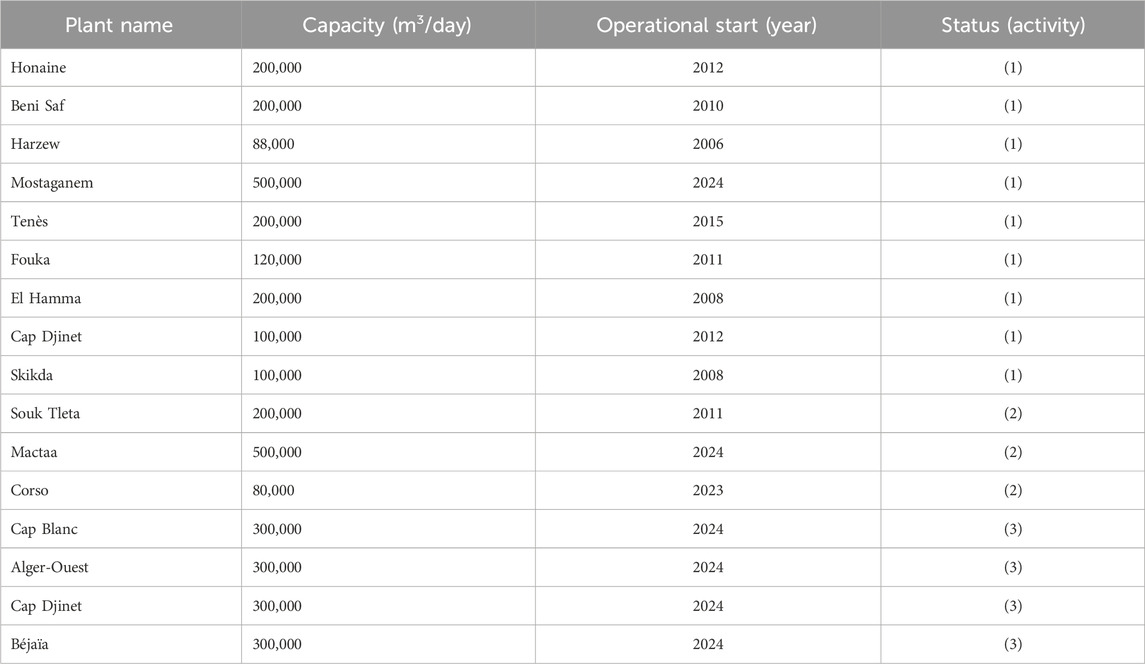
Table 2. RO seawater desalination infrastructure in Algeria between 2005 and 2025—(1) Existing site—(2) Site under construction or rehabilitation—(3) New site.
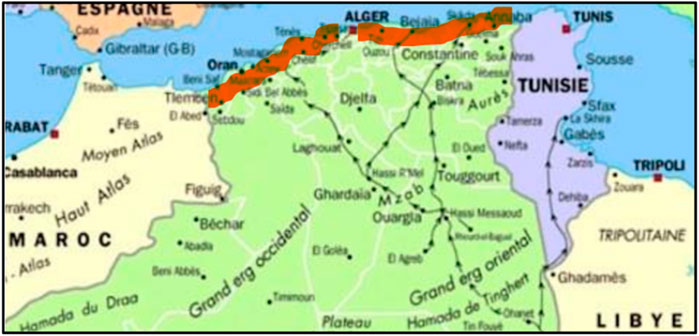
Figure 1. All seawater RO desalination plants are spread across Algeria’s coastal front (brown line) between the cities of Tlemcen and Annaba.
3.1 National needs versus availability of water resources in Algeria
In 2011, the total volume of water consumed by all economic sectors across the entire territory was 11.5 billion m3 (Stambouli A.B. et al., 2016). Specifically, 75% of water withdrawals (i.e., 8.6 billion m3 water per year) were assigned to agricultural land irrigation, and the remaining 25% (i.e., 2.9 billion m3 of water per year) supported demands from the drinking water and industrial sectors. Forecasts for 2030 anticipate an annual consumption nearing 19 billion m3 of water, whereby 82% of water production would be devoted to agricultural withdrawals (Figure 2).
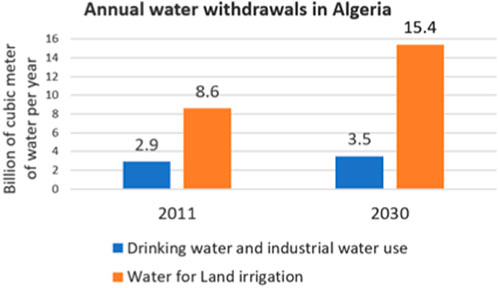
Figure 2. Total water withdrawals, in Algeria with actual and forecast data for 2011 and 2030, respectively (Stambouli A. B. et al., 2016).
Between 1960 and 2020, the national freshwater access has plummeted from about 1,500 to; 300 m3/capita/day, and several countries in Northern Africa have now reached a state of severe water stress, exhibiting clean water withdrawals below 500 m3/capita/day (Sattar and Demmak, 2014; Chaoui et al., 2016; Fanack Water, 2019). Hence, the effects of climate change have led to rising temperatures, prolonged heatwaves, and caused catastrophic environmental outcomes, such as droughts and wildfires. Furthermore, the persistent drop in rain precipitation and fast urbanization experienced in Algeria have contributed to diminish the dams water level and slow down the groundwater recharge rate (Figure 3).
The country chose to address these challenges by building desalination plants (coast), more dams and boreholes (central region), as well as water transfer pipelines in the south (Drouiche N. et al., 2016). While these efforts remain insufficient, new solutions could be sought by adopting an integrated water resources management strategy aiming to
• Fully allocate freshwater resources to consumption needs; seek to recycle/reuse drinking water effluent streams (Kettab, A., 2023; Drouiche N., et al., 2022)
• Promote wastewater recycling to satisfy demands from the agricultural and industrial sectors. Currently, 1.3 billion m3 of waste effluents are produced per year. About 30% of these rejects are connected to sanitation, while the remainder is discharged/lost without further treatment (Mihoubi M.K, 2023).
• Process wastewater effluents by selecting membrane technologies, specifically when high-value-added operations are necessary—i.e., brine dilution, hydrogen production, or waste valorization.
The call for an integrated policy is also justified by the increased frequency and abruptness of global disasters reinforcing risks of water shortages-i.e., disrupted supply of merchandises; pandemics; conflicts; wildfires, etc. During the workshop, experts stressed the need to educate citizens on the importance of preserving all forms of water resources.
3.2 Power consumption and environmental stewardship
The total power capacity installed across the country was estimated at 21 gigawatts (GW) in 2018. Algeria’s energy mix is heavily reliant on fossil fuels and distributed between open-cycle gas turbines (11.5 GW), combined-cycle gas turbines (6.1 GW), steam turbines (2.3 GW), diesel (0.35 GW) and renewable sources (0.7 GW). An ambitious plan has been set to produce around 20 GW of renewable energy by 2035 -i.e., representing 27% of its forecast total electricity production (ITA). Algeria’s large-scale seawater desalination stations (Table 2) are mainly powered by natural gas, and they can release about 14,000 tons of CO2 into the atmosphere each day. This reliance on fossil fuel makes it challenging to drop CO2 emission levels by 7% and to be compliant with the 2015 Paris Agreements (Bloomberg, 2022). Given the projected expansion of RO desalination infrastructure in the coming years (estimate of 5.5 million m3 of potable water produced per day around 2030), promoting resilient and sustainable capacity development will demand careful planning.
During the 2010–2030 period, power consumption assigned to the water sector is expected to rise from 2,600 GWh to 5,700 GWh (Amenhyd company, 2020). The coupling of RO membrane systems with renewable energy sources may offer a viable approach for effectively managing greenhouse gas emissions associated with desalination. Given its annual solar irradiance of 13.9 TWh (one of the highest sun exposure on the planet), Algeria can utilize this abundant resource as a substitute for its fossil fuel reserves. Moreover, the steady drop on solar photovoltaic (solar PV) equipment pricing favors this technology over competing green processes (Figure 4). The opportunities for sustainable growth in desalination are dependent on several factors including 1) RO system scalability, 2) adoption of recycling practices, and 3) quest for innovation.
3.2.1 RO system scalability
Solar PV technologies are well suited for supporting brackish water treatment systems built for small installations, with supply below 1,000 m3 per day of clean water (Goosen M. et al., 2023). This type of equipment can be operated with or without batteries and is particularly useful in areas lacking access to drinking water and stable grid electricity. In terms of power consumption, the specific energy usually varies in the 2 to 5 kWh/m3 range of treated water (Figures 5) (Vince et al., 2008; Charcosset C. et al., 2009; Pinto JM, 2021).
Larger RO installations must be operated continuously to satisfy the local demands. Given the frequent battery loading cycles and the need to deliver a steady electrical output, it is critical to carefully manage and understand the risks of power failure, considering the operational requirements of a desalination plant (El Kharraz, 2023). STM 2023 presented an ongoing study conducted at BeniSaf plant with the testing of hybrid solar PV/RO installations—daily water supply of 200,000 m3. This site is forecast to acquire 30 MWp of solar power supply in the coming decade, thus saving 20 tons of daily CO2 emissions. It is also expected to generate some financial gains after 25 years of green operation. Hence, prioritizing the deployment of solar PV technologies for power generation could accelerate the decline for national natural gas consumption. If the BeniSaf study is conclusive it could be replicated in several other plants in Algeria. However, one shall take into consideration the fate of countless PV materials in service once they have reached their end-of-line life cycle.
3.2.2 Recycling practices
Experts estimate that 8 million metric tons of PV panels will no longer be in operation across the globe by 2030. Without any corrective action, this amount could rise to 80 million metric tons by 2050 (Peplow, 2022). These panels mainly contain glass, polymers, metals, and it is challenging to dismantle them (Figure 6). Consequently, recycling is not commonly practiced, and it can be costly. Legacy solar materials mostly end up in landfills, but the newest products are easier to disassemble, which facilitates the sorting of components and causes less environmental impact. As for the deployment of large hybrid RO plants and assessment of their environmental impact, topics addressing solar waste recycling/prevention should be prioritized.
3.2.3 Quest for innovation
Algeria aims to produce 15 GW of clean power capacity by 2035, representing 40% of its forecast total energy mix (IEF, 2021). Specifically, a key goal for the coming years is to establish some basic capability for green hydrogen production—i.e., preparation of hydrogen by electrolyzing RO-purified seawater. In this case, desalination units must be fully powered by renewable energy sources to operate a green process (Rahmouni et al., 2017). Recently, new studies even suggested recycled wastewater streams as a feedstock for green hydrogen supply (Newborough M., and Cooley G., 2021). Hence, the purification of mildly contaminated effluent streams can be leveraged to generate hydrogen via electrolysis. Such scenario offers a promising path to speed up the implementation of net-zero strategies.
3.3 Centralized versus decentralized and autonomous desalination systems
SWRO desalination currently satisfies 17% of the national drinking water demand, and a conversion rate of 40% is sought with the construction of five new large-scale RO plants by 2025 (Bedouani, H. et al., 2023). Aside from the existing desalination facilities, a dozen SWRO mono-blocks have also been built along the coastal line, enabling a cumulative clean water supply of 57,000 m3/day. The deployment of high-capacity centralized RO systems seems to be favored due to pressing water shortages, however this tactics must be carefully weighed, given its environmental impact—i.e., bigger facilities yield higher CO2 emissions, larger chemical consumption, greater brine production and waste discharge. Decentralization should not be overlooked as it reinforces climate resiliency thanks to broader access to diversified technologies, an increased distribution of risks, and reliance on redundant processes—i.e., critical safeguards in crisis situations.
3.4 Management of goods and services
Several recommendations were made at STM 2023 to address the environmental and health challenges associated with RO desalination operations, including:
- Reduction of raw materials and consumable goods (membrane fabrication; RO processes)
- Preparation of bio-sourced and biodegradable chemicals (membrane synthesis; cleaning fluids)
- Local manufacturing of membrane modules
- Brine recovery and economic valorization
- Recycling of RO module components.
Since most filtration products available in Algeria are imported, the recycling of aging and defective desalination modules has gained a growing interest. This trend has been observed in many other locations where SWRO plants are operated, and it is guided by environmental and economic factors (Pontié, 2015; Pontié et al., 2017). Some studies have established that out-of-specification RO membranes could support UF and NF (nanofiltration) end-use applications (Seibel et al., 2021) or serve as ion exchange membranes following a post-treatment (Somrani A., et al., 2021). In other investigations RO modules were dismantled for the purpose of recycling the polypropylene construction layers into distillation membranes, agricultural geotextiles, as well as fuel products (Seibel L. et al., 2021). These small-scale examples make the case for the reuse and recycling of desalination RO products, which contributes to establishing a circular economy. It is critical to test these promising results in the field considering that the global replacement of RO modules generates 15,000 tons of plastic waste each year (Lawler et al., 2012). Given the ongoing expansion of desalination infrastructure in Algeria, calling for a local/regional fabrication of membrane filtration products makes sense and encourages resiliency—i.e., sand filters, microfiltration (MF) cartridges, RO modules shown in Figure 7.
4 Conclusion
Algeria ranks among the world’s largest producers of freshwater collected via SWRO treatment, with a capacity of 2.2 million m3/day, which represents 17% of its national drinking water demand. This investigation reveals that the deployment of SWRO capabilities is more likely to be resilient when the following actions are undertaken:
⁃ Upgrade RO desalination resources by installing a mix of centralized and decentralized units and displaying a wide range of treatment capacities—i.e., a diversity of solutions promotes resiliency.
⁃ Facilitate the emergence of a local/regional membrane production ecosystem that prioritizes green processes—i.e., sand filters, cartridges, UF and RO modules.
⁃ Build solar PV RO desalination systems, keeping an option for recycling end-of-life components such as PV panels, batteries, electrical wires etc.
Since the root causes of water scarcity are linked to global trends, the lessons learnt are not country-specific but can be applied to any region displaying comparable environmental and socio-economic conditions.
Data availability statement
The original contributions presented in the study are included in the article/supplementary material, further inquiries can be directed to the corresponding author.
Author contributions
SO: Conceptualization, Investigation, Methodology, Resources, Writing–original draft. AD: Conceptualization, Data curation, Investigation, Methodology, Software, Supervision, Writing–original draft, Writing–review and editing.
Funding
The authors declare that no financial support was received for the research, authorship, and/or publication of this article.
Acknowledgments
The authors thank the Agence Nationale de Valorisation des Résultats de la Recherche et du Développement Technologique (ANVREDET) for being invited to the STM 2023 workshop held in Algiers, 30 May–1 June 2023.
Conflict of interest
Author AD is a co-founder and co-owner of Donyatek Company.
The remaining author declares that the research was conducted in the absence of any commercial or financial relationships that could be construed as a potential conflict of interest.
Publisher’s note
All claims expressed in this article are solely those of the authors and do not necessarily represent those of their affiliated organizations, or those of the publisher, the editors and the reviewers. Any product that may be evaluated in this article, or claim that may be made by its manufacturer, is not guaranteed or endorsed by the publisher.
References
Amenhyd (2020). Le dessalement de l'eau: enjeu pour un développement durable. Available at: https://www.amenhyd.com/l’empreinte-carbone-du-dessalement-de-leau-de-mer/L’empreintecarbonedudessalementdel’eaudemer.
Bedouani, H., and Kettab, A. (2023). Déficit hydrique: l’Algérie veut généraliser le dessalement. https://arab.news/wd6b9.
Bloomberg, N. E. F. (2022). Global climat-scope: low carbon strategy. https://www.global-climatescope.org/markets/dz/.
Chaoui, M. S., Benterki, A., and Van Cauwenbergh, N. (2016). Analyse de La poplitique hydrique en algerie depuis L’independence. Rev. Des. Sci. Hum. (46), 65–79. doi:10.34174/0079-000-046-045
Charcosset, C., Falconet, C., and Combe, M. (2009). Hydrostatic pressure plants for desalination via reverse osmosis. Renew. Energy 34 (12), 2878–2882. doi:10.1016/j.renene.2009.02.026
Drouiche, N., Ghaffour, N., Naceur, M. W., Lounici, H., and Drouiche, M. (2016). Towards sustainable water management in Algeria. Desalination Water Treat. 50 (1-3), 272–284. doi:10.1080/19443994.2012.719477
Drouiche, N., Villarreal, O. R., Ouali, S., Lebouachera, S. E. I., and Soni, R. (2022). Role of desalination technologies and water reuse in water-energy-food nexus: an opportunity for Algeria. Desalination Water Treat. 261, 83–93. doi:10.5004/dwt.2022.28538
Eke, J., Yusuf, A., Giwa, A., and Sodiq, A. (2020). The global status of desalination: an assessment of current desalination technologies, plants and capacity. Desalination 495, 114633. doi:10.1016/j.desal.2020.114633
El Kharraz, J. (2023). Economically, renewable desalination is becoming more and more competitive. Smart Water Mag., 64–67. https://smartwatermagazine.com/news/regional-center-renewable-energy-and-energy-efficiency/economically-renewable-desalination.
Fanack Water (2019). Algeria water report: water infrastructure in Algeria. https://water.fanack.com/algeria/water-infrastructure/.
Goosen, M., Mahmoud, H., Alyousef, Y., and Ghaffour, N. (2023). Solar desalination: a review of recent development in environmental, regulatory, and economic issues. Sol. Compass 5 (100034), 1–12. doi:10.1016/j.solcom.2023.100034
Grumbach, S., and Hamant, O. (2020). How humans may co-exist with earth? The case for suboptimal systems. Anthropocene 30, 1–13. doi:10.1016/j.ancene.2020.100245
Himri, Y., Rehman, S., and Mostafaeipour, (2022). Overview of the role of energy resources in Algeria’s renewable energy transition. Energies 15 (13), 1–26. doi:10.3390/en15134731
Hong, L., Dumond, M., Zhu, M., Tsugawa, S., Li, C. B., Boudaoud, A., et al. (2018). Heterogeneity and robustness in plant morpho-genesis: from cells to organs. Annu. Rev. Plant Biol. 69, 469–495. doi:10.1146/annurev-arplant-042817-040517
International Desalination Association (2017). Global water intelligence. https://idadesal.org/international-desalination-association-and-global-water-intelligence-release-new-data-in-30th-worldwide-desalting-inventory/.
International Energy Forum IEF (2021). Algeria powers ahead with huge renewable energy plans. https://www.ief.org/news/algeria-powers-ahead-with-huge-renewable-energy-plans.
Kettab, A. (2023). Algérie: faire face au stress hydrique le traitement des eaux usées ? Arab News. https://arab.news/53xxy.
Lawler, W., Bradford-Hartke, Z., Cran, M. J., Duke, M., Leslie, G., Ladewig, B. P., et al. (2012). Towards new opportunities for reuse, recycling and disposal of used reverse osmosis membranes. Desalination 299, 103–112. doi:10.1016/j.desal.2012.05.030
Mihoubi, M. K. (2023). Dessalement et traitement des eaux usées: des solutions « incontournables » au Maghreb. Saudi Arabia-ArabnewsSaudi Research and Publishing Company; https://arab.news/nzqtb.
Miu, A., Balakrishnan, H., and Koksal, C. E. (2005). “Improving loss resilience with multi-radio diversity in wireless networks”. in Proceedings of the 11th annual international conference on Mobile computing and networking. New York, N.Y. USA: Association for Computing machinery, 16–30. doi:10.1145/1080829.1080832
Newborough, M., and Cooley, G. (2021). Green hydrogen: water use implications and opportunities. Fuel Cells Bull. 2021 (12), 12–15. doi:10.1016/S1464-2859(21)00658-1
Peplow, M. (2022). Solar panels face recycling challenge. Chem. Eng. News 8 (8), 299–302. doi:10.1021/acscentsci.2c00214
Pinto, J. M. (2021). Energy consumption and desalination. Available at: https://uh.edu/uh-energy/educational-programs/tieep/content/energy-recovery-presentation-2020-water-forum.pdf.
Pontié, M. (2015). Old RO membranes: solutions for reuse. Desalination Water Treat. 53 (6), 1492–1498. doi:10.1080/19443994.2014.943060
Pontié, M., Awad, S., Tazerout, M., Chaouachi, O., and Chaouachi, B. (2017). Recycling and energy recovery solutions of end-of-life reverse osmosis (RO) membrane materials: a sustainable approach. Desalination 423, 30–40. doi:10.1016/j.desal.2017.09.012
Rahmouni, S., Negrou, B., Settou, N., Dominguez, J., and Gouareh, A. (2017). Prospects of hydrogen production potential from renewable resources in Algeria. Int. J. Hydrogen Energy 42 (2), 1383–1395. doi:10.1016/j.ijhydene.2016.07.214
Sattar, A. A., and Demmak, A. M. (2014). Algeria water sector M&E rapid assessment report. MEWINA Algeria Water Sect. Monit https://web.cedare.org/wp-content/uploads/2005/05/Algeria-Water-Sector-Monitoring-and-Evaluation-Rapid-Assessment-Report.pdf.
Seibel, F. I., Giubel, O. M., Briao, V. B., Shabbani, M., and Pontié, M. (2021). End-of-life reverse osmosis membranes Recycle procedure and its applications for the treatment of brackish and surface water. J. Appl. Res. Water Wastewater 8 (1), 77–87. doi:10.22126/ARWW.2021.6499.1214
Somrani, A., Shabani, M., Mohamed, Z., Ghaffour, N., Seibel, F., Briao, V. B., et al. (2021). Transforming and end-of-life reverse osmosis membrane in a cationic exchange membrane and its application in a fungal microbial fuel cell. Ionics 27 (7), 1–16. doi:10.1007/s11581-021-04070-5
Stambouli, A. B., Hamiche, A. M., and Flazi, S. (2016). A review on the water and energy sectors in Algeria: current, forecasts, scenario and sustainability issues. Renew. Energy Power Qual. J. 14, 27–34. doi:10.24084/repqj14.217
Keywords: RO desalination, solar photovoltaic, decentralization, sustainabilify, wastewater, solar equipment recycling, water scarcity, resiliency
Citation: Ouali S and Doucoure A (2024) Adopting sea water reverse osmosis desalination technologies for sustainable development: lessons learnt from Algiers Science and Technology for membranes 2023 workshop. Front. Membr. Sci. Technol. 3:1352799. doi: 10.3389/frmst.2024.1352799
Received: 08 December 2023; Accepted: 15 March 2024;
Published: 10 April 2024.
Edited by:
Ahmad Fauzi Ismail, University of Technology Malaysia, MalaysiaReviewed by:
Zahra Samavati, University of Technology Malaysia, MalaysiaRosyiela Azwa Roslan, University of Technology Malaysia, Malaysia
Yawei Du, Hebei University of Technology, China
Copyright © 2024 Ouali and Doucoure. This is an open-access article distributed under the terms of the Creative Commons Attribution License (CC BY). The use, distribution or reproduction in other forums is permitted, provided the original author(s) and the copyright owner(s) are credited and that the original publication in this journal is cited, in accordance with accepted academic practice. No use, distribution or reproduction is permitted which does not comply with these terms.
*Correspondence: A. Doucoure, abdoulaye.doucoure@donyatek.org
 S. Ouali1,2
S. Ouali1,2  A. Doucoure
A. Doucoure